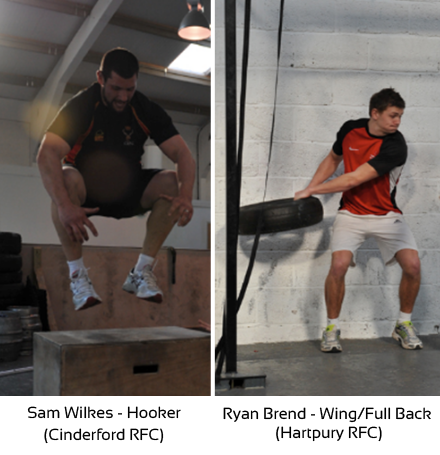PART 1: Featured Training
To kick-start this month’s Fitness Blog, please allow me to introduce you to two athletes that I am currently working with:
Both players’ are well into their playing season and playing some of their best rugby yet. In terms of their physical development/maintenance, as a coach I have seen how easily they have transferred their gym training onto the pitch. As a result it is not a rarity to see Sam run over people like a steam train or Ryan casually out pace players to the try line. For their egos sake, I will say no more!
In line with this blogs emphasis on power development, I have utilized some “Unconventional Training Techniques” in their training focussing on powerful and explosive movements. Three of these movement patterns are demonstrated below and there are more to come next month.
PART 2: Unconventional Training Techniques
Well, let’s get the ball rolling, or shall I say TYRE! This month I will be showing you how you can use an old tyre to effectively develop key muscles used in various aspects of the rugby game. Firstly, get down to your local car garage and the odds are they will chuck you a few old tyres for free.
Our core muscles stabilise countless rugby specific movement patterns and so if you want to be stronger in the contact area, for example, tackle harder or have the ability to stay on your feet longer when being tackled then these exercises couldn’t be more specific.
For the purpose of this blog, consider this a short guide to developing your effectiveness the tackle area. That aside, the best thing is these exercises will not only increase your physicality and explosiveness in the tackle but also contribute to the physical development of various other movements with in a rugby game.
1. Tyre Rotations
Just a few example game-specific situations:
- Being tackled and remaining stable enough to make an effective pass/offload;
- Rotating to make a tackle; and
- Having the ability to ensure you are not turned in the tackle area, and land on the right side to present the ball correctly in the ruck.
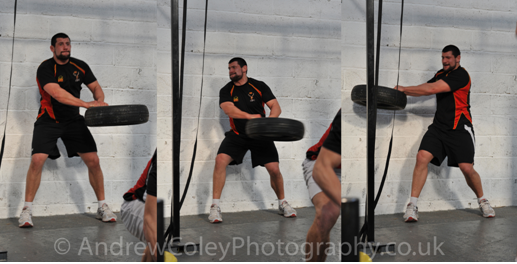
Step 1:
- Position your body approximately parallel to the wall. If this range of movement is challenging then you can position yourself at a slight angle to the wall, essentially reducing the range in which you have to rotate to make contact between the tyre and wall.
- Place your hands on the top of the tyre. In terms of positioning, ensure they are reasonably close but still comfortably situated.
- With regards to foot position, place your feet approximately just wider than shoulder width apart.
Step 2:
- Maintaining a tight and strong core positioning, this step is all about being as explosive as possible. The aim here is to essentially make as much contact with the wall through the tyre as possible.
- Allow your body to move with the tyre, generating force through your whole body.
Step 3:
- Upon contact with the wall your body now has to stabilise the force you created. Think of it as Newton’s third law, for every action there is an equal and opposite reaction.
- It is important to focus on maintaining a solid, balanced position, utilizing all of your stabilizing muscles.
- Following contact with the wall ensure you return to Step 1 in a strong up right up position.
The picture below is a breakdown of the whole movement from start to finish.

GYM ALTERNATIVE
If you are a die-hard gym user or can’t get your hands on a tyre, then the following exercises offer an alternative approach.
- Barbell core rotations
- Cable rotations
These exercises will not incorporate the “shock component” and may also be a great way to develop the key muscles used in this movement. Accordingly, for those that find the workload too demanding, start with these with these alternatives first.
2. Impact Hammer Swings
Just a few example game-specific situations:
- Pulling a player down to the floor in a tackle/grappling situation;
- Going low into a ruck situation and driving upwards to force players off the ball; and
- Keeping a strong core position in the scrum.
This exercise is as simple as it looks, swing the sledgehammer towards the tyre, hit the tyre with as much force as possible and swing the sledgehammer back up to the top phase of the movement (as pictured below).

Just like Tyre Rotations this movement also incorporates the stabilisation component. Upon making impact with the tyre you will have to effectively control the force as a result of the sledgehammer bouncing back off the tyre.
Both the swing towards the tyre and the return to the Top Phase should be treat as a full body movement. The picture below demonstrates the change in body position from the Top Phase to making contact with the tyre:
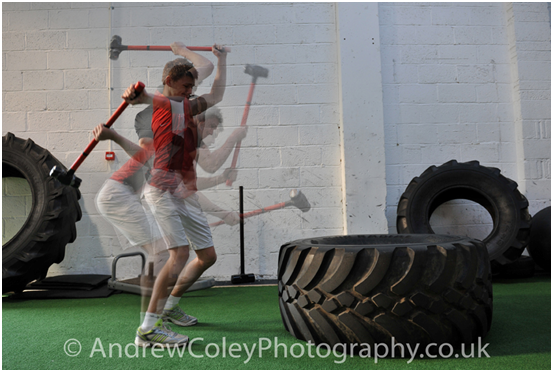
GYM ALTERNATIVE
If you are a die-hard gym user or can’t get your hands on a tyre, then the following exercises offer an alternative approach.
- Medicine ball slams
- Kettlebell swings
These exercises will not incorporate the “shock component” and may also be a great way to develop the key muscles used in this movement. Accordingly, for those that find the workload too demanding, start with these with these alternatives first.
3. Extended Throw
Just a few example game-specific situations:
- Exploding into a tackle, both offensively and defensively;
- Hitting scrums, rucks and mauls; and
- Ability to use the full body in a hand off situation.
This exercise is incredibly specific to the tackle situation. As any Strength and Conditioning coach will tell you, these triple extension movements are so relevant and specific to rugby.
The idea here is that you are able to generate force up from the floor to the top of the movement. Accordingly, in terms of your starting position, you need to keep your core muscle fixed, with the movement initiating from the legs upwards.
The picture below shows your body position for starting the Extended Throw. You should not feel any of this workload through your back muscles. Prior to getting into position, take a big breath of air in and when down in the start position, keep your back flat as though you are going to scrummage, keep your shoulders slightly above your hips with your chin off your chest and chest out.
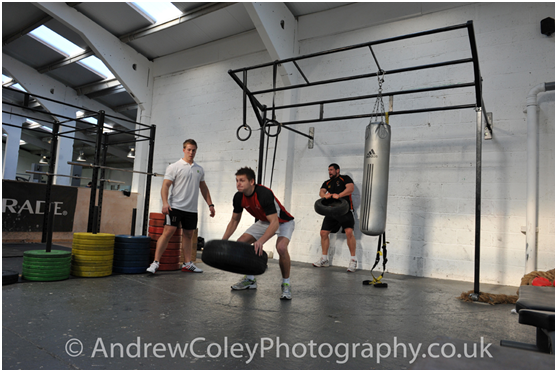
Starting Position
When carrying out the movement you are exploding not only upwards but slightly forwards also. Imagine an opponent has run at you and you are powerfully hitting the tackle. The tyre not only provides an amount of resistance with the movement but also contributes to the development or various other muscles used.
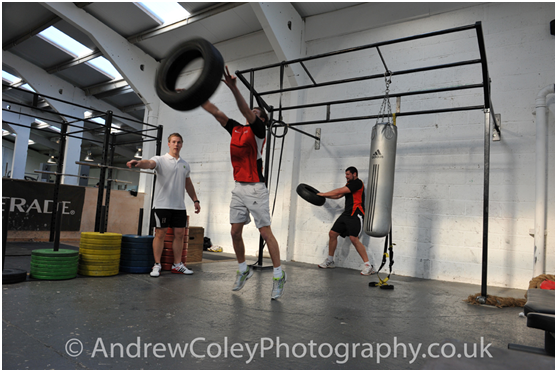
Finishing Position
GYM ALTERNATIVE
If you are a die-hard gym user or can’t get your hands on a tyre, then the following exercises offer an alternative approach.
- Medicine ball throws
- Kettlebell swings
These exercises will not incorporate the “shock component” and may also be a great way to develop the key muscles used in this movement. Accordingly, for those that find the workload too demanding, start with these with these alternatives first.
PART 3: Questions and Answers
I look forward to hearing all of your questions regarding rugby fitness and conditioning and I endeavour to answer as many questions as possible in each blog. Accordingly, for future reference, this section will be where the Questions and Answers will be situated.
Please email me at Jack@findrugbynow.com and check back here next month for more rugby-specific fitness and conditioning guidance.








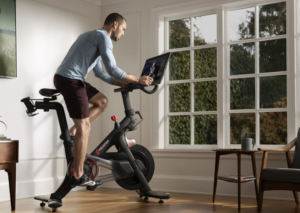 When most people hear the word “Peloton” they think of an expensive black bike with shiny red buttons and that controversial commercial where the husband gifted his wife a Peloton for Christmas.
When most people hear the word “Peloton” they think of an expensive black bike with shiny red buttons and that controversial commercial where the husband gifted his wife a Peloton for Christmas.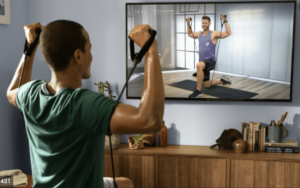 If the app interests you, Peloton is currently offering a 30 day FREE TRIAL, so why not give it a try? Check it out
If the app interests you, Peloton is currently offering a 30 day FREE TRIAL, so why not give it a try? Check it out 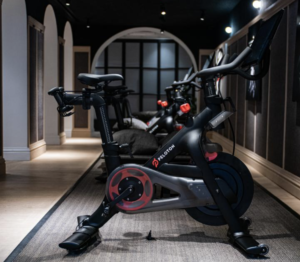
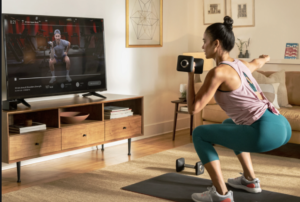
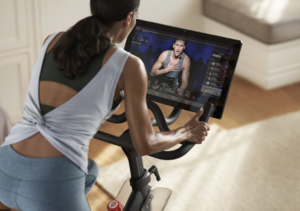 This article would not be complete, however, if we did not acknowledge some of the delivery issues that have been plaguing Peloton over the last year. Most of the delivery issues seem to affect U.S. deliveries, however, the UK deliveries have been affected as well.
This article would not be complete, however, if we did not acknowledge some of the delivery issues that have been plaguing Peloton over the last year. Most of the delivery issues seem to affect U.S. deliveries, however, the UK deliveries have been affected as well.





